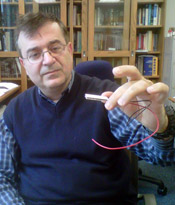Researchers from Northwestern University have succeeded in developing an innovative material with which electricity can be produced from heat-producing devices, such as vehicle exhaust systems, industrial processes and devices, as well as sunlight, in a more efficient manner than was previously known.

There is great value in the innovative material and it has a high thermoelectric capacity that enables the conversion of 14 percent of the heat losses into electricity. The findings, the result of joint research by chemists, physicists and materials experts, were published in the scientific journal Nature Chemistry.
"It has been known for about a hundred years that semiconductors have this ability to generate electricity," says researcher Mercouri Kanatzidis, professor of chemistry at Northwestern University. "In order to turn this ability into an efficient and useful process, all you need is the right material, and we managed to discover a recipe/system for making such a material."
The researchers were able to develop such a material by dispersing rock salt nanocrystals (SrTe) within the material lead telluride (PbTe). Previous attempts in this area of including nanoscale materials within a larger material succeeded in improving the energy conversion efficiency of lead telluride, but this combination also caused increased electron scattering leading to reduced overall conductivity. In this study, the researchers provide the first ever example of the use of nanostructures embedded in lead telluride in order to reduce electron scattering and increase the material's energy conversion efficiency.
"We can put the new material into an inexpensive device with few electrical wires and connect it to another system, such as a light bulb," said the lead researcher. "The addition we introduced can improve the efficiency of the bulb's activity by utilizing the heat generated in the bulb and converting part of it, 15-10%, into a more useful form of energy, such as electricity."
The automotive, chemical, construction and glass industries, which use heat to produce their products, will be able to make their systems and equipment more efficient thanks to this scientific breakthrough, explains the lead researcher.
"The energy crisis and environmental awareness are two main reasons why our discovery is so exciting, but our findings could only be the beginning," notes one of the researchers. "These types of structures could have other applications in the different fields of science that we haven't even thought of, in areas such as mechanical behavior and improving the stiffness and strength of new materials. We hope that others will be able to take advantage of our new system and use it in diverse fields."
